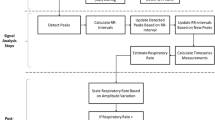Abstract
To evaluate the possibility of respiratory-volume measurement using photoplethysmography (PPG), PPG signals from 16 normal volunteers are collected, and the respiratory-induced intensity variations (RIIV) are digitally extracted. The RIIV signals are studied while reepiratory volume is varied. Furthermore, respiratory rate, body posture and type of respiration are varied. A Fleisch pneumotachograph is used as the inspired volume reference. The RIIV and pneumotachography signals are compared, and a statisical analysis is performed (linear regression and t-tests). The key idea is that the amplitude of the RIIV signal is related to the respiratory volume. The conclusion from the measurements is that there exists a relationship between the amplitude of the RIIV signal and the respiratory volume (R=0.842, s=0.428, p<0.005). Absolute measurements of the respiratory volume are not possible from the RIIV signal with the present set-up. The RIIV signal also seems to be affected by respiratory rate and type. More knowledge about respiratory parameters and improved sensor and filter design are required to make absolute measurements of volumes possible.
Similar content being viewed by others
References
Ahmed, A. K., Harness, J. B., andMearns, A. J. (1982): ‘Respiratory control of heart rate’,Eur. J. Appl. Physiol.,50, pp. 95–104
Allison, R. D., Holmes, E. L., andNyboer, J. (1964): ‘Volumetric dynamics of respiration as measured by electrical impedance plethysmography’,J. Appl. Phys.,19, pp. 166–173
Ashutosh, K., Gilbert, R., Auchincloss, J. H., Erlebacher, J., andPeppi, D. (1974): ‘Impedance pneumograph and magnetometer methods for monitoring tidal volume’,J. Appl. Phys.,37, pp. 964–966
Brecher, G. A. (1956): ‘Venous return’ (Grune & Stratton, New York)
Challoner, A. V. J. (1979): ‘Photoelectric plethysmography for estimating cutaneous blood flow’in Rolfe, P. (Ed.): ‘Non-invasive physiological measurements’ (Academic Press, London) pp. 125–151
Cyna, A. M., Kulkarni, V., Tunstall, M. E., Hutchinson, J. M. S., andMallard, J. R. (1991): ‘Aura: a new respirtory monitoring and apnoea alarm for spontaneously breathing patients’,Br. J. Anaesth.,67, pp. 341–345
Davis, D. L., andBaker, C. N. (1969): ‘Comparison of changes in blood volume and opacity in dog digital pad and tongue’,J. Appl. Physiol.,27, pp. 613–618
Dorlas, J. C., andNijboer, J. A. (1985): ‘Photo-electric plethysmography as a monitoring device in anaesthesia’,Br. J. Anaesth.,57, pp. 524–530
Eldrup-Jorgensen, S., Schwartz, S. I., andWallace, J. D. (1966): ‘A method for clinical evaluation of peripheral circulation: Photoelectric hemodensitometry’,Surgery,59, pp. 505–513
Elings, H. S. (1959): ‘Fotoelektrische plethysmografie met behulp van diffuus gereflekteered licht’, Thesis, Groningen University, The Netherlands
Foster, A. D., Neumann, C., andRovenstine, E. A. (1945): ‘Peripheral circulation during anaesthesia, shock and haemorrhage: the digital plethysmograph as a clinical guide’,Anaesthesiology,6, pp. 246–257
Hamilton, L. H., Beard, J. D., Carmean, R. E. andKory, R. C. (1967): ‘An electrical impedance ventilometer to quantitate tidal volume and ventilation’,Med. Res. Eng.,6, pp. 11–16
Henneberg, S., Hök, B., Wiklund, L., andSjödin, G. (1992): ‘Remote auscultatory patient monitoring during magnetic resonance imaging’,J. Clin. Mon.,8, pp. 37–43
Hering, E. (1869): ‘Über den Einfluss der Atmung auf den Kreislauf’,Sber. Akad. Wiss. Wien,60, p. 829
Hertzman, A. B., andSpealman, C. R. (1937): ‘Photoelectric plethysmography of the fingers and toes in man’,Proc. Soc. Exp. Biol. Med.,37, pp. 529–534
Hök, B. (1991): ‘Microphone design for bio-acoustic signals with suppression of noise and artifacts’,Sens. Actuators A,25–27, pp. 527–533
Hök, B., Wiklund, L., andHenneberg, S. (1993): ‘A new respiratory rate monitor: Development and initial clinical experience’,Int. J. Clin. Monit. Comp.,10, pp. 97–103
Johansson, A. andÖberg, P. Å. (1996): ‘Uppskattning av andningsvolym med fotopletysmograf’ National medical convent, Stockholm, Abstract, p. 276 (in Swedish)
Johansson, A., andÖberg, P. Å. (1998): ‘Estimation of respiratory-volumes from the photoplethysmographic signal II: A model study’,Med. Biol. Eng. Comput.,37, 00–00.
Lentz, G., andHeipertz, W. (1991): ‘Capnometry for continous postoperative monitoring of nonintubated, spontaneously breathing patients’,J. Clin. Mon.,7, pp. 245–248
Lindberg, L.-G., Ugnell, H., andÖberg, P. Å. (1992): ‘Monitoring of respiratory and heart rates using a fibre-optic sensor’,Med. Biol. Eng. Comput.,30, pp. 533–537
Mayer, S. (1876): ‘Über spontane Blutdruckschwankungen’,Sber. Akad. Wiss. Wien,74, p. 281
Penaz, J. (1978): ‘Mayer waves: history and methodology’,Automedica,2, pp. 135–141
Roy, J., McNulty, S., andTorjman, M. (1991): ‘An improved nasal prong appratus for end-tidal carbon dioxide monitoring in awake, sedated patients’,J. Clin. Mon.,7, pp. 249–252
Sara, C. A., andShanks, C. A. (1978): ‘The peripheral pulse monitor—a review of electrical plethysmography’,Anaesth. Intens. Care,6, pp. 226–233
Sheperd, J. T., andVanhoutte, P. M. (1975): ‘Veins and their control’ (W. B. Saunders Company Ltd, London) pp. 134–179, pp. 190–209
Sullivan, W. J., Peters, G. M., andEnright, P. L. (1984): ‘Pneumotachographs: Theory and clinical application’,Respiratory Care,29, pp. 736–749
Traube, L. (1865): ‘Über periodische Tätigkeitsänderungen des vasomotorischen und Hemmungs Nervenzentrums’,Cbl. Med. Wiss.,56, p. 880
Ugnell, H. (1995): ‘Photoplethysmographic heart and respiratory rate monitoring’, Thesis 386, Department of Biomedical Engineering, Linköping University, Linköping, Sweden
Vegfors, M., Ugnell, H., Hök, B., Öberg, P. Å., andLennmarken, C. (1993): ‘Experimental evaluation of two new sensors for respiratory rate monitoring’,Physiol. Meas.,14, pp. 171–181
Author information
Authors and Affiliations
Rights and permissions
About this article
Cite this article
Johansson, A., Öberg, P.Å. Estimation of respiratory volumes from the photoplethysmographic signal. Part I: experimental results. Med. Biol. Eng. Comput. 37, 42–47 (1999). https://doi.org/10.1007/BF02513264
Received:
Accepted:
Issue Date:
DOI: https://doi.org/10.1007/BF02513264




